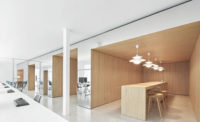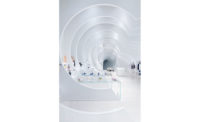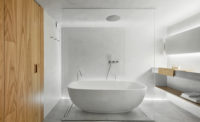MM House by OHLAB
Palma de Mallorca, Spain

The architects created a street facade for the single-family residence that resembles a group of small Mediterranean houses, its smooth, white stucco walls and square windows concealing the design’s complex geometry.
Photo © José Hevia

Large glazed openings blur the divide between interior and exterior and serve to fully integrate the house with the garden, where native vegetation and deciduous trees abound.
Photo © José Hevia

The kitchen and living area can be experienced as a single open space or separated by a sliding door.
Photo © José Hevia

A mezzanine study leads to a triangular terrace in the house’s central volume.
Photo © José Hevia

The master suite features stunning views; a sliding door connects to the bath.
Photo © José Hevia

A mezzanine study leads to a triangular terrace in the house’s central volume.
Photo © José Hevia

Image courtesy OHLAB

Image courtesy OHLAB

Image courtesy OHLAB









Architects & Firms
Five years ago, against the advice of friends and family, a Majorcan couple decided to build a new house on the island off the Spanish coast. Though they were nearing retirement, and Spain’s economy was still shaky, they went ahead and commissioned OHLAB, a Palma-based firm that has been gaining an international reputation (record, October 2016, page 108, and September 2013, page 94). Now the distinctive design of the MM House (so called for the names of the adventurous husband and wife, Margalida and Miquel) has won a 2016 World Architecture Festival award—but, more important, it has deeply satisfied the clients’ wishes. On a sloped site at the edge of the Tramuntana mountains, just outside Palma (Majorca’s largest city), the house is based on a straightforward concept. Divided into four connected boxes, it is, according to the owners, “Simple, clean, and elegant.”
Once OHLAB cofounders, Jaime Oliver and Paloma Hernaiz, understood the clients’ vision for their home—a peaceful, low-maintenance oasis where they could be just as comfortable hosting their children and grandchildren as they would be living by themselves—the architects proposed the solution that immediately won the couple’s approval. “We were captivated by the model,” Margalida says. “Its triangular rooftop balcony fascinated us, and the entrance reminded us of the white houses of Ibiza.”
Sitting at the top of a half-acre site, the starkly geometrical house is made of reinforced concrete covered with an External Thermal Insulation Composite System (ETICS—the equivalent of an Exterior Insulation Finishing System [EIFS] in the United States) and finished in white stucco. “The structure is concrete because, even though it looks quite simple, there are a lot of complicated structural moments,” Oliver explains. For instance, the upper floor of the main volume cantilevers over the kitchen and master-bedroom boxes, providing a visual segue among the separate forms.
With a total area of 2,100 square feet, the four boxes—each accommodates a different function—have panoramic windows directed toward the garden, the sea, or the city beyond. The main entrance leads inside the central box, which faces the Mediterranean and houses the living/dining area on the ground floor and an elevated study on the way to a rooftop balcony. The south-facing kitchen block looks onto a vegetable garden, while on the other side, the remaining two boxes harbor the master bedroom and guest rooms, both of which enjoy views of Palma’s Gothic Bellver Castle and the cityscape.
The modular arrangement of the living areas ensures that the house adapts to the needs of the clients at any given moment. It can be used as a one-bedroom dwelling when there are no visitors, and—depending on whether the sliding door is open or closed—the kitchen and social areas can be experienced as a single, fluid space or completely separate rooms.
In spite of the partitioned plan, the architects’ palette of materials contributes to the fluidity of the interior spaces. Pinewood furniture echoes the window frames, and green and beige hydraulic floor tiles flow throughout the various spaces. With only these colors, in two size formats, Oliver and Hernaiz created a different pattern for each box: predominantly beige with touches of green inside, and the reverse on the rooftop balcony. According to Hernaiz, “The tiles represent a sort of abstraction of the house’s exterior and surrounding vegetation,” so they not only unify the interiors but also connect them with the exterior.
Sustainability and low maintenance costs were priorities, so the architects designed the house to the Passivhaus standard. Large, recessed, south-facing glazed openings let in the low winter sun while protecting the house from the high summer sun, and smaller openings on the opposite facades allow cross ventilation. In addition to the building’s ETICS facade, OHLAB incorporated such technologies as a solar water heater, heat exchanger, and hydronic radiant-floor heating and cooling systems.
Located within a 2011 UNESCO World Heritage site, and with a tradition of rainwater storage that was first developed by the Arabs during the Middle Ages, the entire house is a complex water-collection system, which the architects developed with the owners. Rain falling onto its pitched roofs is guided through a filtering system into two underground water tanks: a 1,413-cubic-foot tank for irrigation and a smaller, 283-cubic-foot one for drinking water. The house is “completely autonomous in terms of water,” the architects say.
During its first two winters, the house’s thermal insulation was more efficient than expected, with the average interior temperature of 71.6 degrees Fahrenheit. “When the weather starts to cool, people ask us if we have the heating on and are very surprised when we say no,” Margalida says. During its first summer, however, the inverse happened, with interior temperatures reaching 82.4 degrees Fahrenheit. In order to prevent the house from overheating during the early hours of the morning, when the sun is low, the design team placed exterior curtains made of agricultural shade mesh in the garden-facing windows.
OHLAB will continue to monitor the performance of the house and make improvements to the design accordingly. As Oliver puts it, “Every project is like a baby; you don’t want to get too far away.”
Next: Forest House by Envelope A+D
CreditsArchitect: OHLAB Calle Manuel Guasp 6a 07006 Palma de Mallorca +34 971 919 909 www.ohlab.net
Personnel in architect's firm who should receive special credit: Architects: Paloma Hernaiz, Jaime Oliver, Ohlab Team: Rebeca Lavín, Walter Brandt, Sergio Rivero de Cáceres Quantity Surveyor: Jorge Ramón
Structural engineer: Jesús Alonso
Consultant: Anne Vogt (Energy efficiency advisor)
General contractor: Mihai Niculai, SL
Photographer: José Hevia / +34 93 451 4563 / www.josehevia.es
|
SpecificationsStructural system Reinforced concrete
Exterior cladding ETICS (External Thermal Insulation Composite Systems) – by BAUMIT (www.baumit.es)
Roofing Ceramic tiles – by Cas Cerámica (www.casceramica.com)
Windows Wooden frame – by Carpintería Palmer (www.carpinteriapalmer.es)
Glazing Glass by Cristalería Bellver ( www.cristaleriabellver.com)
Doors Wooden doors – by Carpintería Palmer (www.carpinteriapalmer.es) Sliding doors - by Carpintería Palmer (www.carpinteriapalmer.es)
Hardware By JNF (www.jnf.pt/es/empresa-jnf)
Interior finishes Wood Paneling – by Carpintería Palmer (www.carpinteriapalmer.es) Flooring - by HUGUET (www.huguetmallorca.com)
Furnishings Kitchen chair: Eames Plastic Side Chair DSW – VITRA Client’s furniture: Cesca chair - KNOLL, Nº18 Thonet chair - THONET
Lighting Interior ambient lighting: LEDS Downlights: LEDS
Plumbing Light series - PAFFONI Sofia series - ROCA
Energy Energy management or building automation system - by UNIFRIO, SA |














